The New Squadron Of Junghans Meister Pilot Models
Junghans looks back to its Bundeswehr pilot’s chronograph of the 1950s as inspiration for its new Meister Pilots.
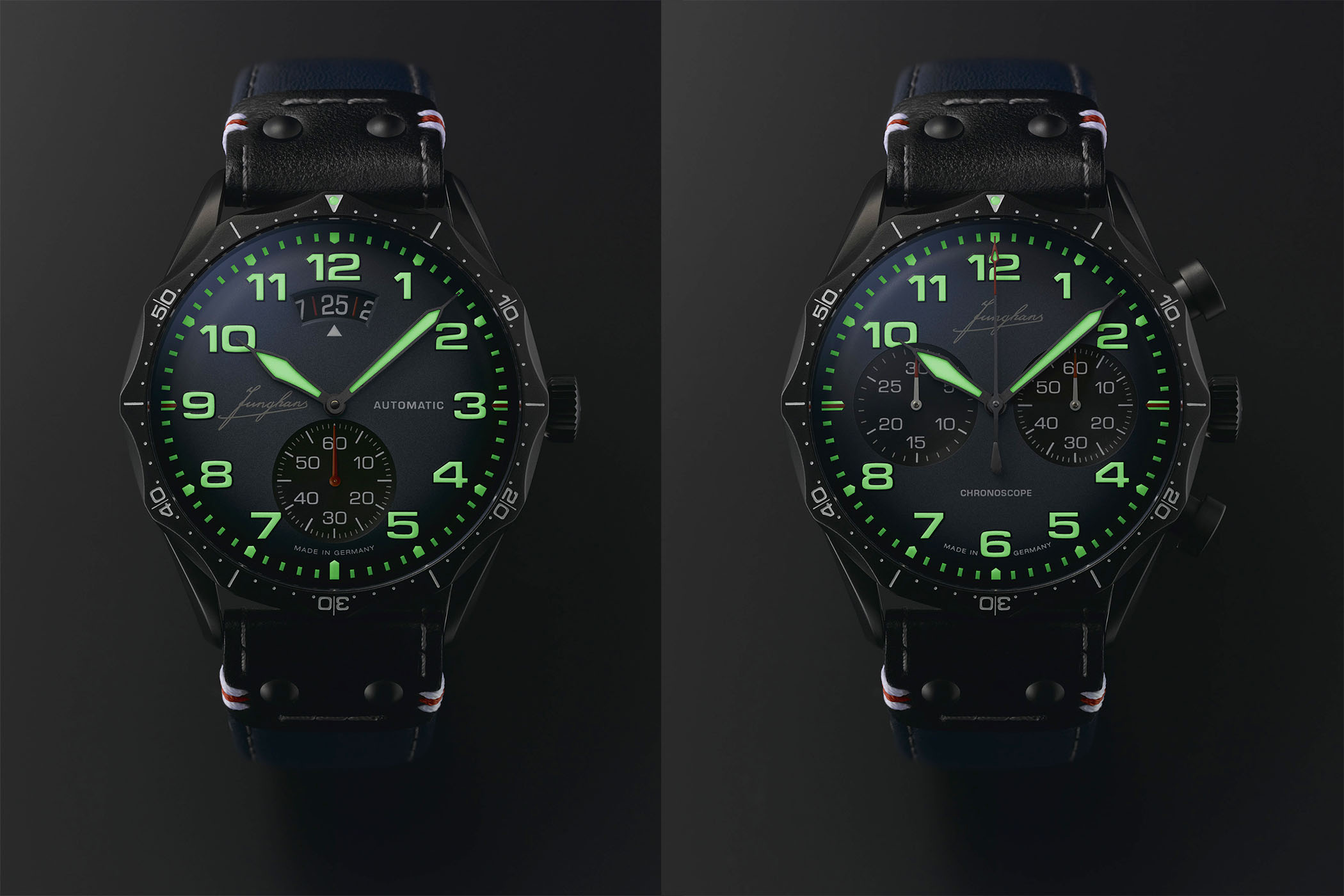
While most of us associate Junghans with understated German design with touches of Bauhaus rationality, there is a lesser-known chapter in the brand’s life as a manufacturer of cockpit clocks for Zeppelins and aeroplanes at the dawn of the 20th century. A few decades later, in the 1950s, Junghans was asked to develop a pilot’s chronograph for the Bundeswehr (German armed forces). Exuding the vintage charm of their predecessor but upgraded with black DLC-coated cases and contemporary movements, the three Meister Pilots joining the collection are represented by two Pilot Chronoscope chronographs and one Meister Pilot Automatic.
Founded in 1861 in Schramberg, Germany, by 1903, Junghans had become the largest clock manufacturer in the world, manufacturing more than 9,000 pieces a day. Leaning heavily on the design influences of the time, many of Junghans’ contemporary models reveal a strong Bauhaus spirit. Another source of inspiration, incarnated by the Meister Driver Handaufzug, comes from the early 20th-century automobiles and the speedometers developed by the company.
A more unfamiliar chapter in the brand’s history is the production of flight instruments or airship clocks. One of the earliest airship clocks is the L55, used in the cockpit of the Zeppelin LZ66 airship that set a record altitude of 7,600 metres in 1917 to evade British reconnaissance planes. In the 1930s, Junghans produced a special clock system for passengers to keep track of local time as they travelled over multiple time zones. Using electronic synchronisation, with a central control clock in the control gondola, the auxiliary clocks in the cabins and dining areas kept passengers updated. Additionally, Junghans supplied onboard clocks for various aircraft, including the Messerschmitt Me 110 in the 1930s.
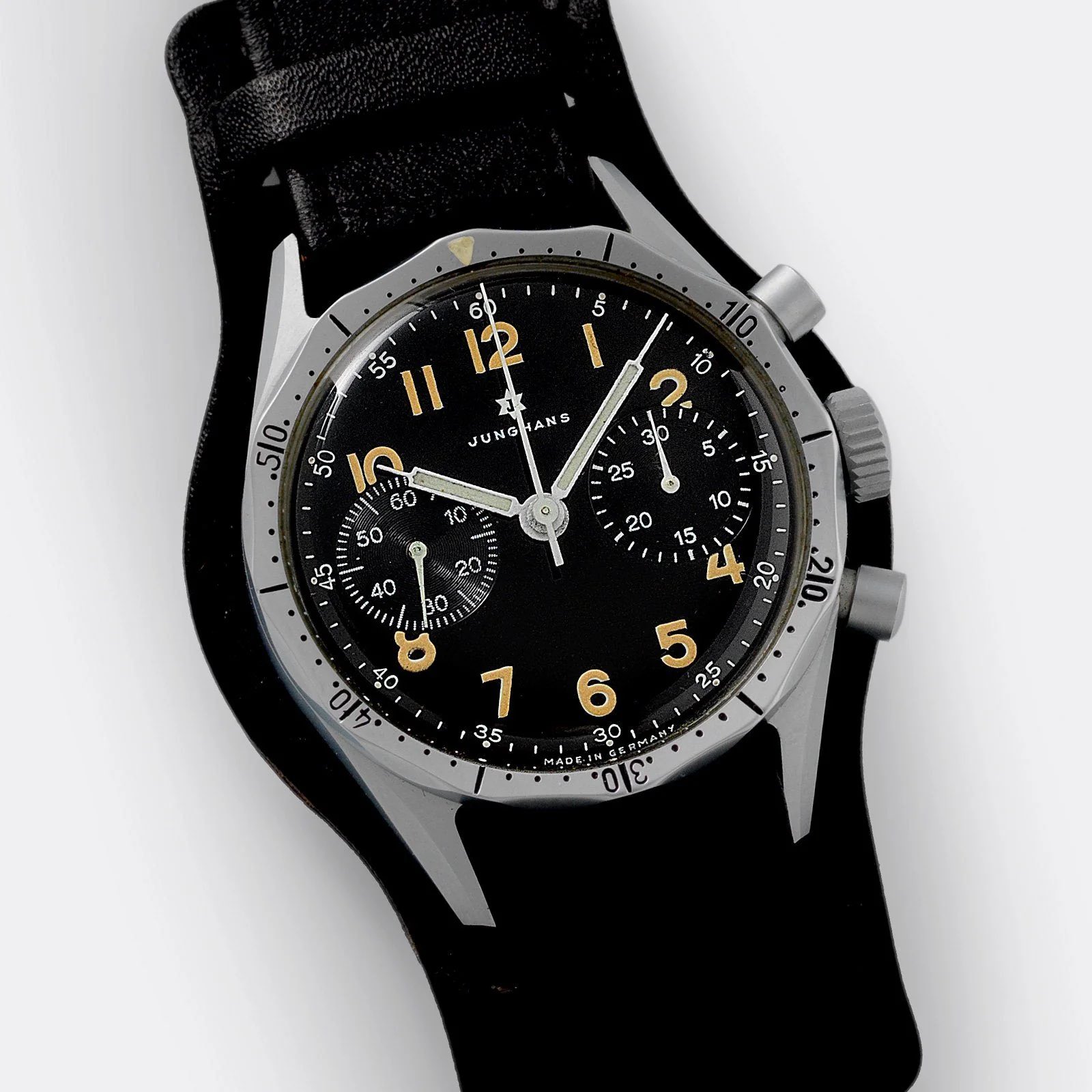
Following its experience with onboard clocks, in the 1950s, Junghans was awarded a contract to produce a service watch for the pilots of the Bundeswehr. Powered by the J88 intermediate wheel chronograph movement tested for centrifugal forces, the style of this Bundeswehr Chronograph, with its 12 deeply grooved notches on the bezel, is the design source of the new Meister Pilot Chronoscope and Meister Pilot Automatic models.
Meister Pilot Chronoscope Navy & desert
Offered with gradient navy blue or sand-coloured dials, the scalloped 12-sided bezel and piston-pushers of the Pilot Chronoscope recreate the profile of the original Bundeswehr Chronograph. The ergonomically designed bi-directional bezel with its clear 10-minute white markings provides good grip and harks back to the days when pilots needed to manipulate the bezel with gloved hands to measure flight duration.
Measuring 43.3mm across with a thickness of 14.4mm, the black-DLC or brown-DLC coated case, pushers, and crown give the watch a more modern vibe. The 100m water-resistant case has a stainless steel convex caseback with seven screws. The navy blue Meister Pilot Chronoscope is a limited edition of 300 pieces and features a hand-engraving of the legendary American Curtiss P-40 Warhawk of the US Air Force on its caseback. The Meister Pilot Chronoscope Desert is not a limited edition and features a stylised aeroplane motif on the caseback.
Legibility is excellent, and the domed dials rely on large luminous Arabic numerals and hands coupled with a luminous peripheral minutes/seconds track that emit a green glow in low light conditions. The pip on the inverted orientation triangle at noon on the bezel is also treated with lume. To underscore the instrument pilot watch character of the chronograph, the markers at 3 and 9 o’clock have a red line to simulate an artificial horizon.
The bicompax layout, with the 30-minute counter at 9 and the small seconds at 3 o’clock, provides the tight symmetry of the dial and the two counters are picked out in a darker colour (black for the blue dial, darker brown for the sand dial) and have red-tipped hands matching the central seconds hand. The historical logo of Junghans appears just below noon but, surprisingly, is more ‘historical’ than the logo that was featured on the original 1950s Bundeswehr Chronograph.
Fitted with blue or sand-coloured leather straps, the rivets, like those found on Flieger watches, add to the vintage spirit. Junghans has equipped the Meister Pilot with calibre J880.4, an automatic chronograph movement based on an ETA 2824 with a Dubois Depraz 2030 chronograph module. The balance has a frequency of 28,800vph, and the power reserve is of 38 hours.
Quick facts: 43.3mm diameter x 14.4mm thickness – stainless steel with black or brown DLC coating – screwed convex caseback with aircraft motif – bi-directional concave 12-notched bezel with luminous pip at noon – 100m water-resistance – domed dial in gradient navy blue or sand colour – bicompax display (small seconds at 3, 30-min counter at 9 o’clock) – luminous hands, indices and min/sec track – domed sapphire crystal with AR coating on both sides – calibre J880.4 (ETA 2824 base with Dubois Depraz chronograph module) – 28,800vph – 38h power reserve – leather strap with rivets and DLC-coated steel buckle – ref. 27/3396.00 Meister Pilot Chronoscope Navy Blue limited to 300 pieces EUR 2,590 (incl. tax) – ref. 27/3398.00 Meister Pilot Chronoscope Desert – EUR 2,590 (incl. tax)
Meister Pilot Automatic
Sharing the same case diameter (43.3mm) as the two chronographs, the Meister Pilot Automatic has a slightly thinner height of 12.5mm. The black-DLC coated, 100m water-resistant case features the signature 12-sided concave bezel of the original Bundeswehr Chronograph, giving these watches their attractive retro appeal. Still offering bi-directional functionality, the bezel has white 10-minute markings with a luminous pip at noon. Like the chronographs, the caseback is also convex, sealed with seven screws, and decorated with a stylised engraving of an aeroplane, but it has a black DLC coating.
Available with a navy blue domed gradient dial, the Pilot Automatic displays an arched window at noon for the date disc with a black background and white numerals, evoking the style of some vintage cockpit instruments measuring oil pressure and temperature. The Arabic numerals, hands are minutes track, are treated with luminescent material, and the red markings indicate the artificial horizon at 3 and 9 o’clock. Slightly recessed, the small seconds counter at 6 o’clock creates a vertical counterpoint to the date window and is black and indicated by a red hand.
Beneath the solid caseback is the automatic calibre J800.1.6 (ETA base) with a 38h power reserve. Like the Navy Blue chronograph, this model is fitted with a navy blue leather strap with rivets.
Quick facts: 43.3mm diameter x 12.5mm thickness – stainless steel with black DLC coating – screwed convex caseback with aircraft motif – bi-directional concave 12-notched bezel with luminous pip at noon – 100m water-resistance – domed dial in gradient navy blue – date window at noon, small seconds at 6 o’clock – domed sapphire crystal with AR coating on both sides – calibre J880.1.6 (ETA base) – 38h power reserve – navy blue leather strap with rivets and black DLC-coated steel buckle – ref. 27/4397.00 – EUR 1,990 (incl. tax)
For more information, please consult junghans.de.

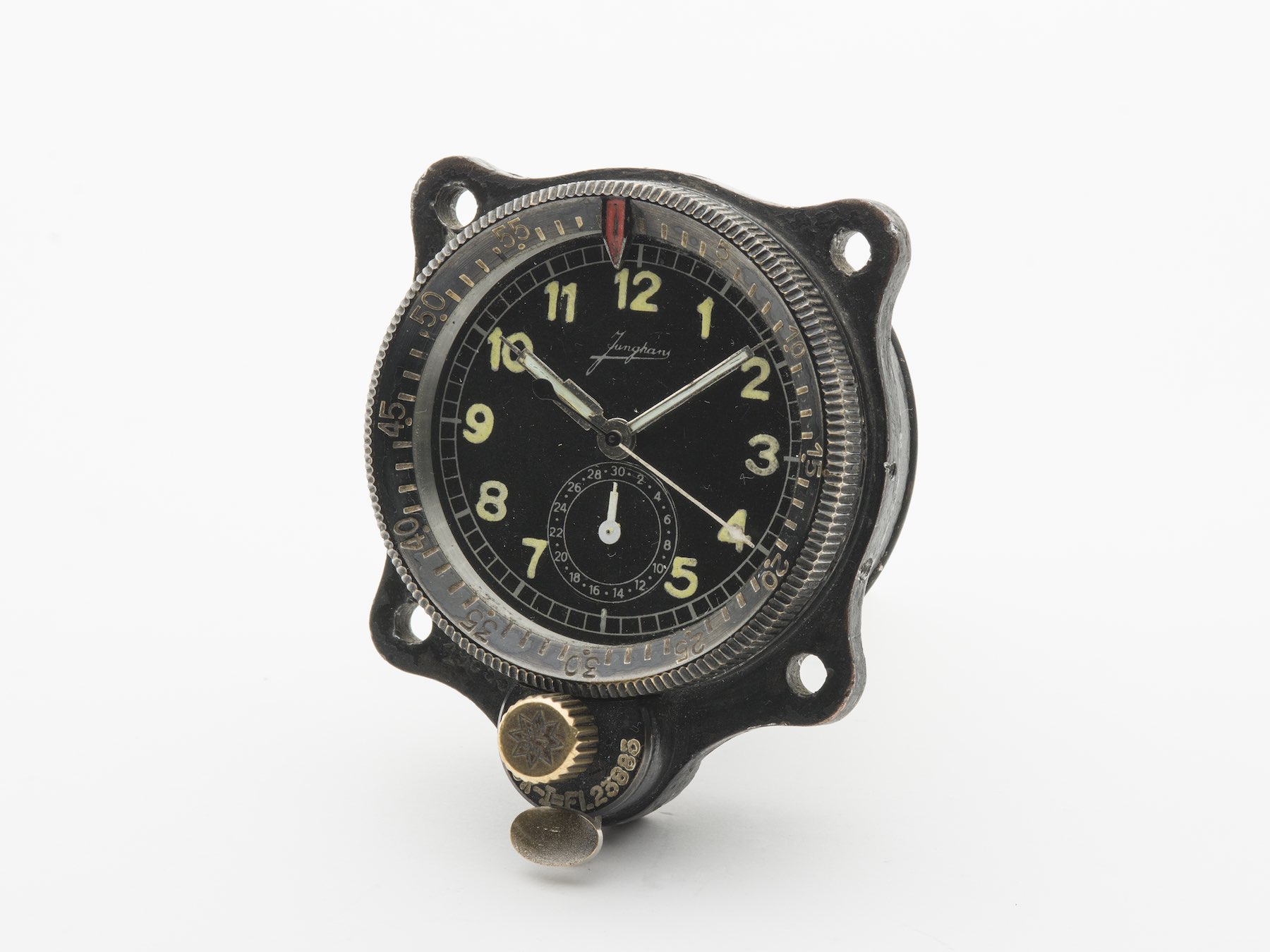

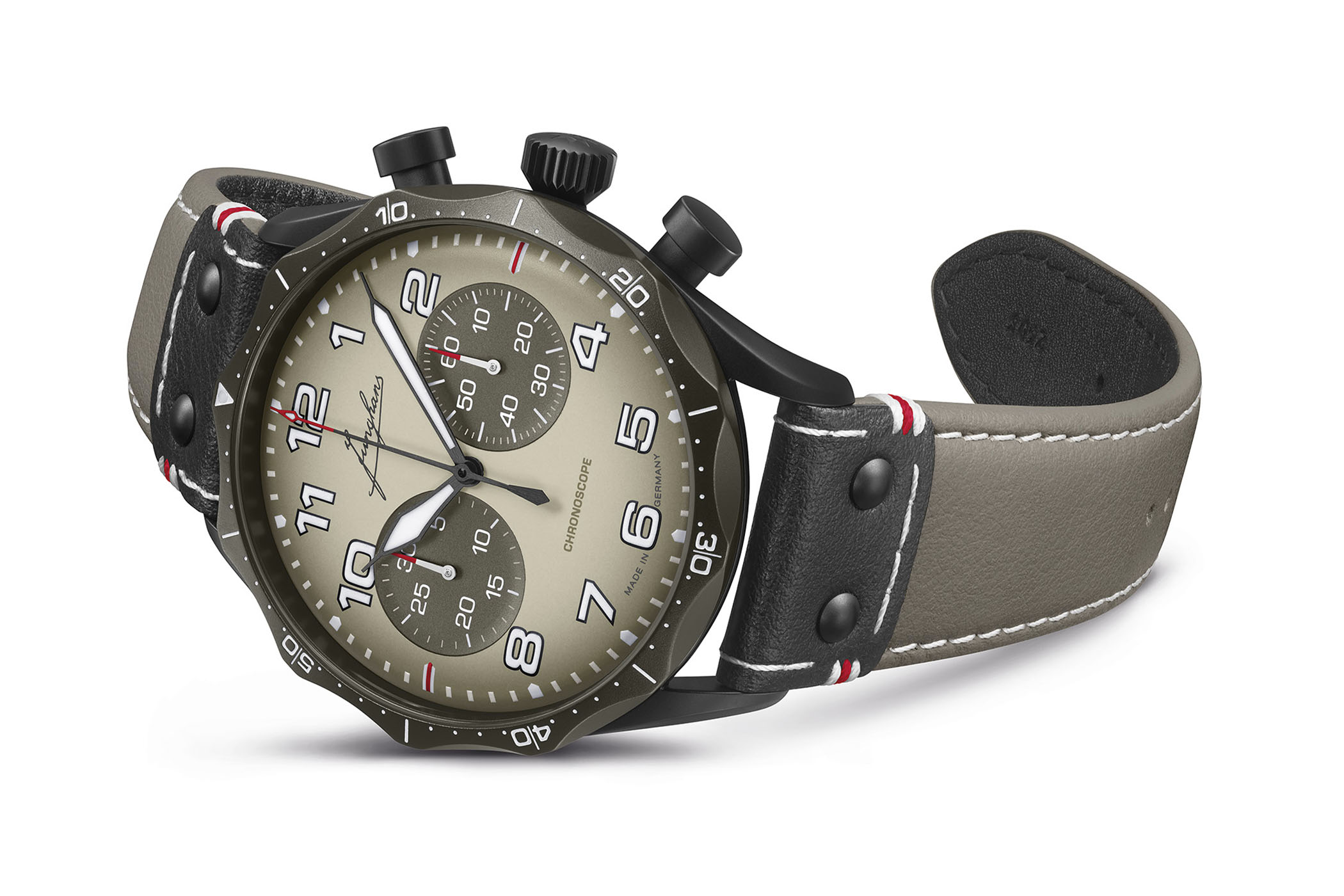

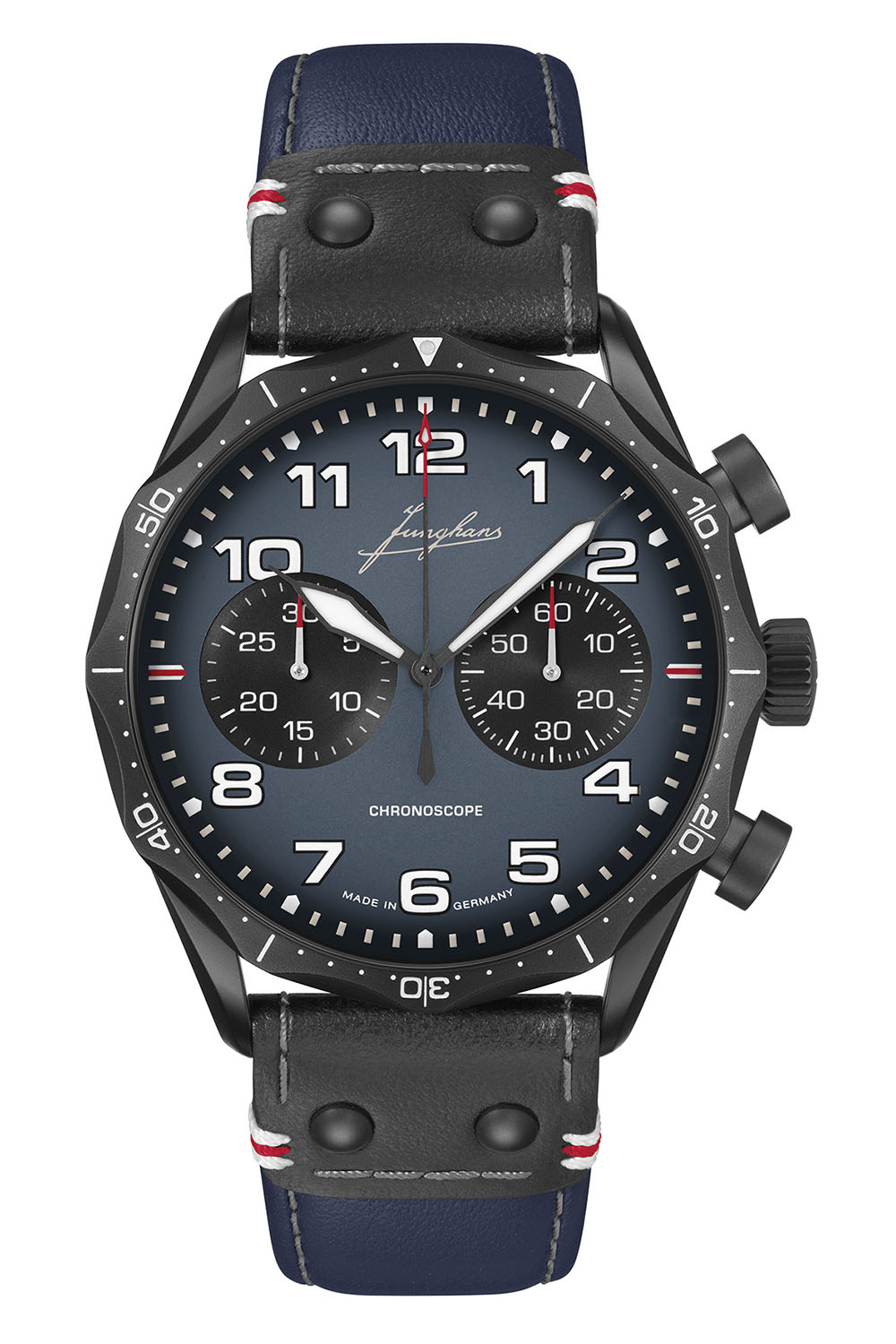
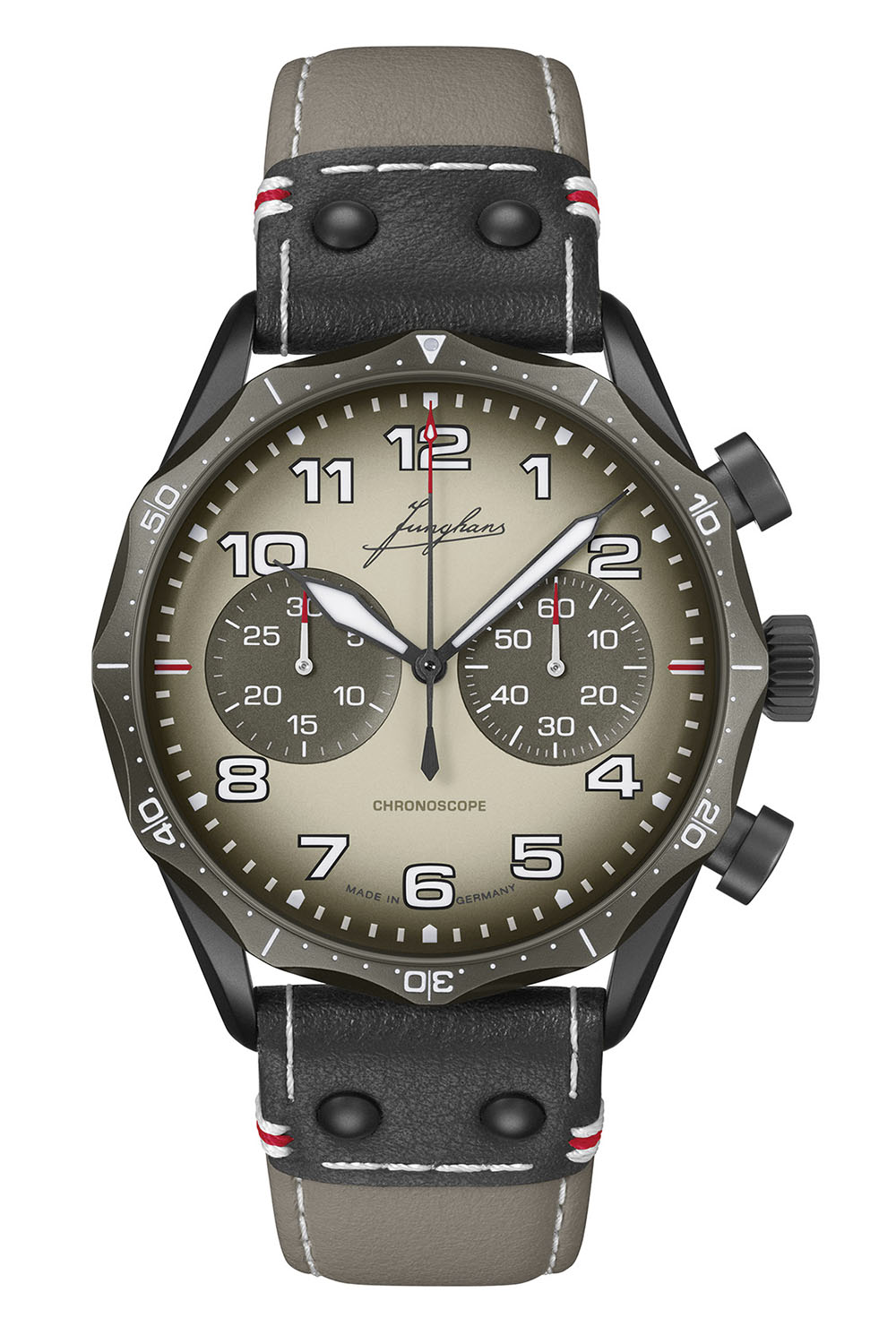
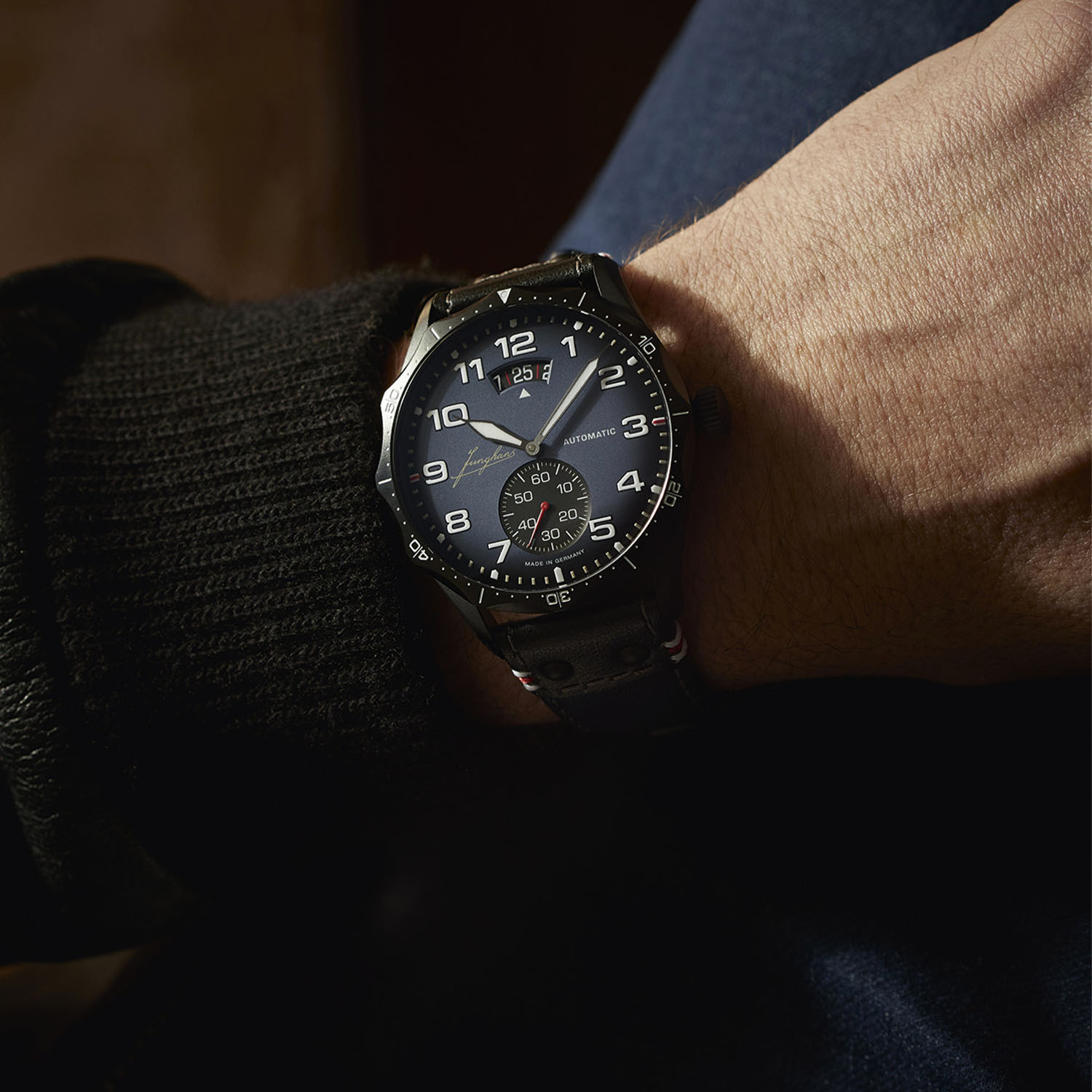
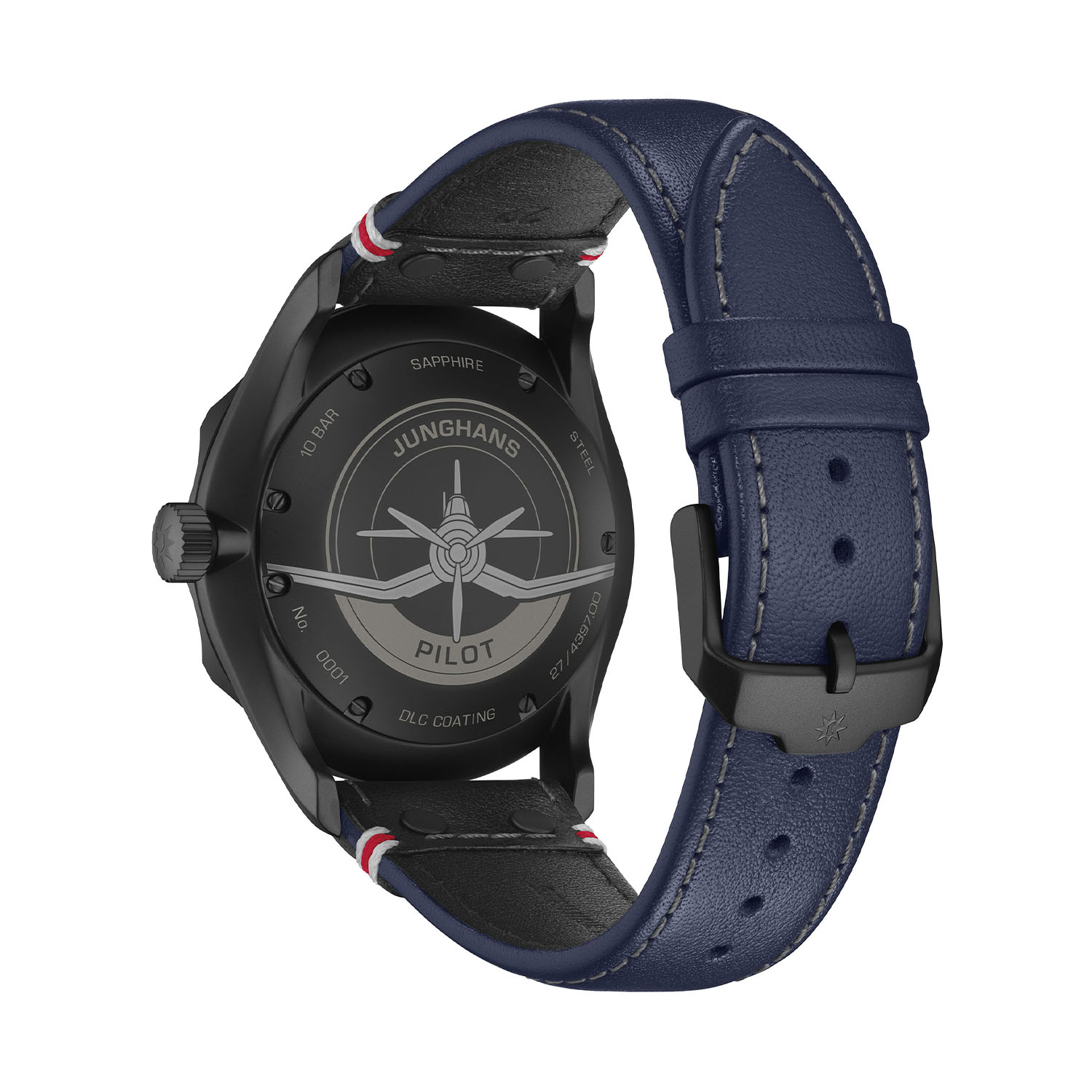
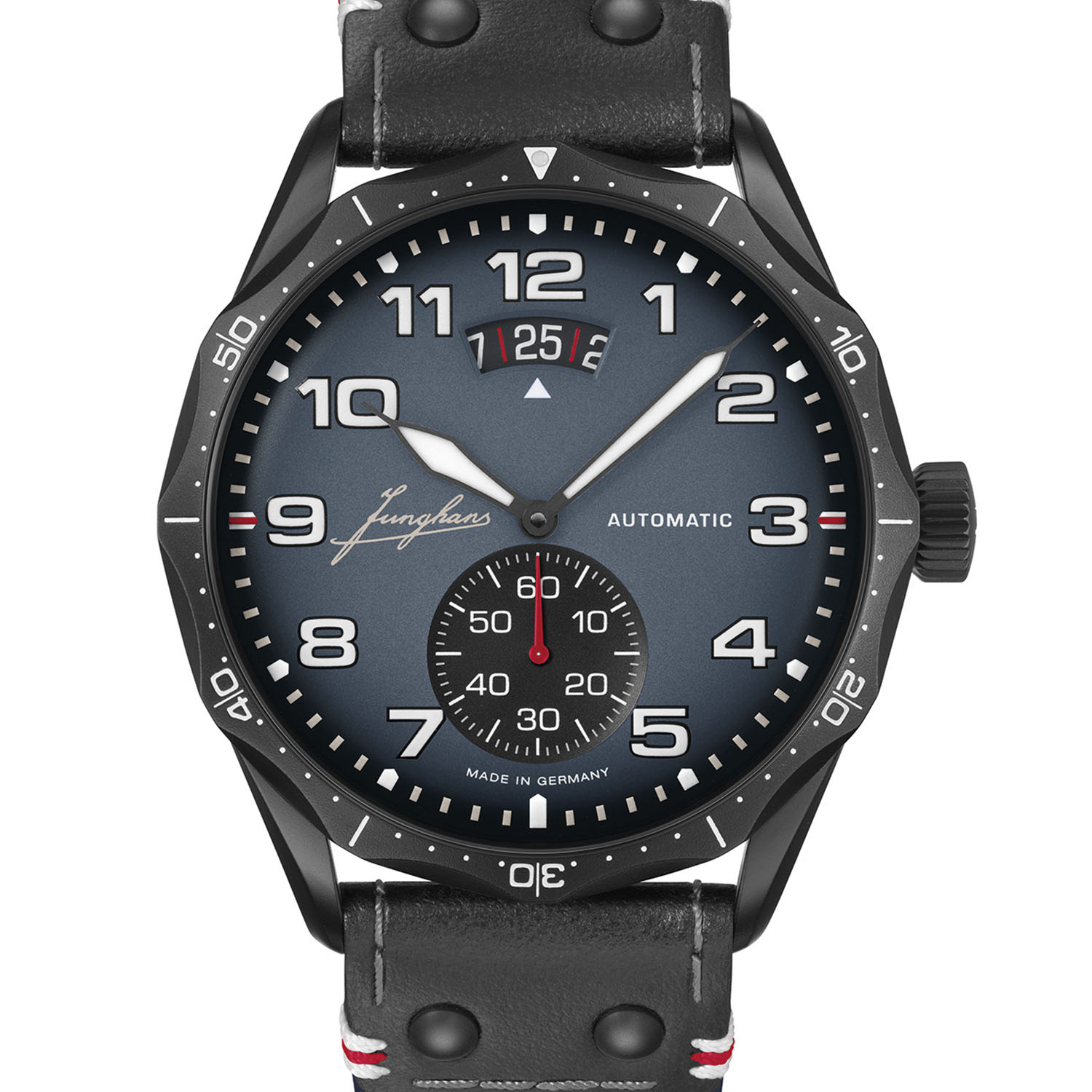



1 response
Very happy I bought the old one.